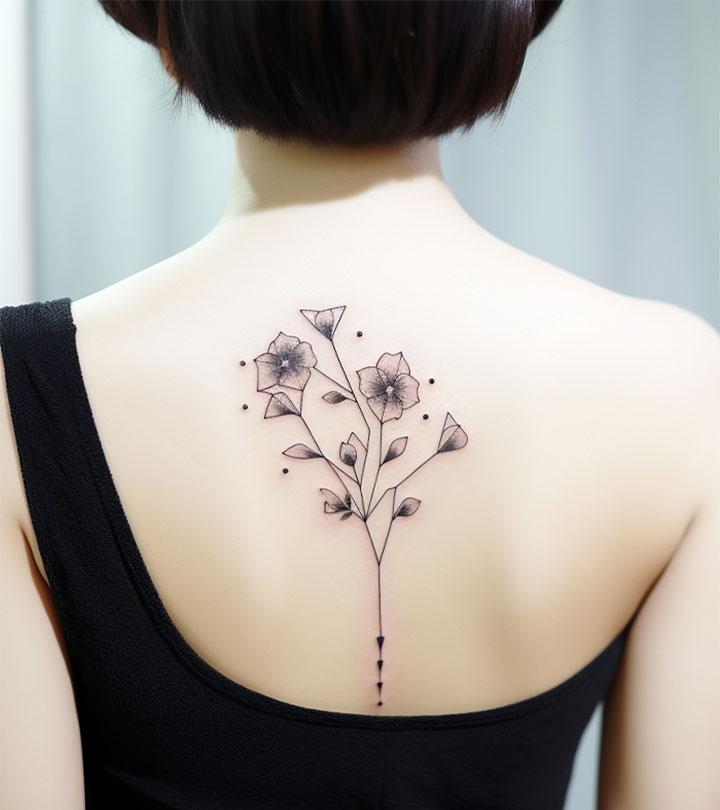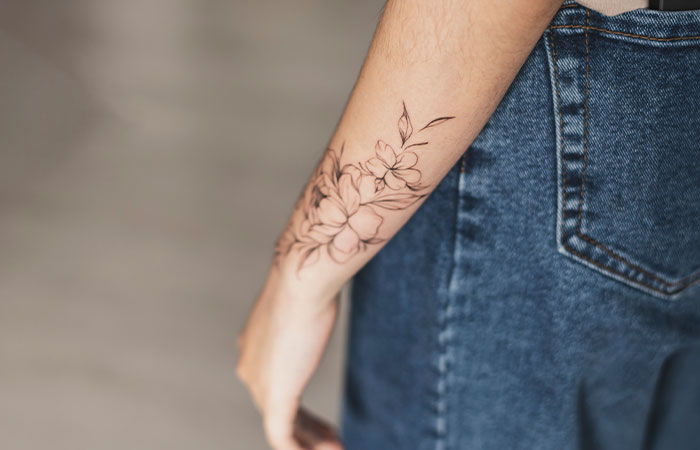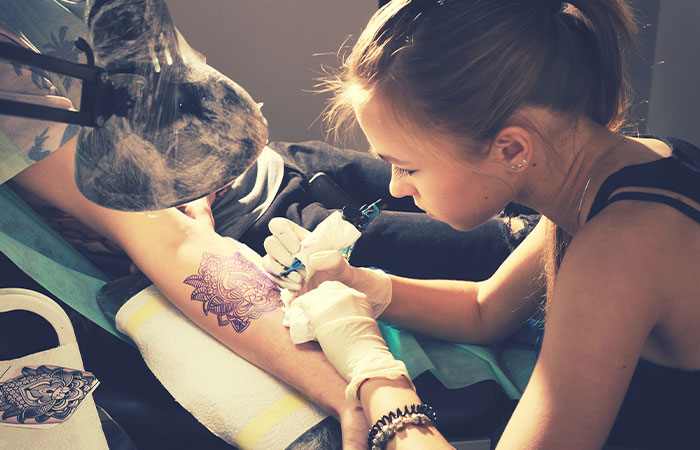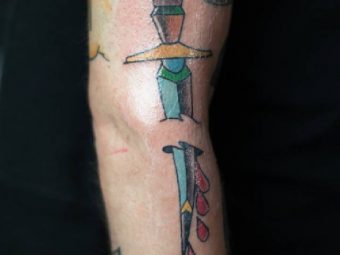What Are Fine Line Tattoos? Do They Age Well?
Explore the delicate artistry of fine line tattoo art and the extent of their longevity.

Image: Created with Midjourney
In the realm of tattoo artistry, fine line tattoos have emerged as a distinctive and sought-after style. These dainty tattoos, characterized by delicate and intricate lines, represent a form of artistic expression that has captivated many tattoo enthusiasts. The beauty of fine line tattoo art lies in its ability to succinctly represent meaning through with a minimalist touch. As individuals consider this aesthetic choice, a pertinent question that follows is do fine line tattoos age well? In this article, we will delve into the characteristics of fine line tattoos and contemplate how they stand the test of time, unraveling the nuances associated with the aging process of this particular tattoo style. Embark on a journey to understand the enduring allure and potential considerations of a well-executed fine line tattoo in the ever-evolving world of body art.
In This Article
What Are Fine Line Tattoos?
Fine line tattoos, known for their thin and delicate line art designs, make for a soft and elegant look. The rising popularity of these tattoos is evident in tattoo shops, driven by celebrities and influencers flaunting their delicate ink on TikTok. Despite being a current trend, fine line tattooing has its roots in the 90s, where it was known as micro tattoos. Over time, advancements in technology and tattoo machines have refined this art form, with options like single-needle tattoo designs boasting of the thinnest lines. Skilled tattoo artists can now incorporate intricate detailing, offering a broader range of possibilities for those who prefer fine lines in tattoos. This evolution has made fine line tattoos one of the biggest tattoo trends in recent times, blending modern design with a retro appeal.
Much has been highlighted about the delicate technique that this tattoo art employs, but why choose this format of body art? Keep reading to learn about all the benefits of fine line tattoos in the next section!
Benefits Of Fine Line Tattoos
1. Subtlety And Elegance
Fine line tattoos are known for their subtle and elegant appearance. The delicate lines make for a refined and sophisticated look and are suitable for those who prefer a more understated and minimalist aesthetic for a lasting impression.
2. Versatility
Fine line tattoos are versatile and can be adapted to various styles, colors and designs. Whether you are interested in geometric shapes or botanical illustrations, or bold tattoos with intricate patterns, fine lines can be used to create detailed and visually appealing tattoo art.
 Quick Tip
Quick Tip3. Faster Healing
Due to the smaller needle size used in fine line tattooing, the healing process may be quicker compared to thicker lines or more elaborate designs. The smaller punctures result in less trauma to the skin, potentially reducing healing time.
4. Less Pain
Some individuals find that fine line tattoos are less painful than bolder, more substantial designs. The thinner lines require less ink saturation and may cause less discomfort during the tattooing process.
Mari Tran, a YouTuber, shared her experience on fine line tattoos, stating in her video, “It wasn’t bad at all. It really just felt like a needle just pricking your skin, like when you’re getting an injection or umm getting your blood drawn. It almost felt like that but it wasn’t as bad. The pain was doable, I could do it, so yes, that is all I have to say (i).”
5. Discreet Placement
The subtlety of fine line tattoos makes them well-suited for discreet body placements. They can be easily hidden or showcased, depending on personal preference.
While fine line tattoos are made of thin lines that make them less painful to get, does this significant structural detail affect its aging? Explore whether fine line tattoos age well in the following section.
Do Fine Line Tattoos Age Well?
Fine line tattoos usually age well because of their simple and delicate design. The thin lines keep their sharpness over time. However, the placement of a fine line tattoo affects how it ages. Tattoos on fingers, hands, face, and neck fade faster because these areas are always exposed to daily wear and tear, and the layer of skin experiences quite a bit of friction. To keep a fine line tattoo looking good for longer and to protect it from exposure to sunlight and other affective elements, consider getting it on your arm, ankle, shoulder, or thigh.
As is the case with all tattoos, the aftercare plays a significant role in making a tattoo stand out and speeding up the healing time. Read on to find out the proper aftercare instructions to follow to achieve the best long-lasting results.
Fine Line Tattoo Aftercare Tips
- Clean the tattoo by gently washing with lukewarm water and a fragrance-free soap that is mild on the skin.
- Dry your tattoo by gently patting it with a clean, dry, and lint-free paper towel. Avoid rubbing your tattoo at all costs.
- Apply a thin layer of tattoo-specific antibiotic ointment to promote healing and prevent infections.
- Protect your tattoo from exposure to sunlight and tanning booths for at least 14 days. After healing, apply sunscreen with at least SPF 30 to prevent fading.
- Resist the urge to pick at scabs; let them naturally fall off to avoid scarring.
- Wear loose, breathable clothing to prevent irritation and allow the tattooed skin to breathe.
- Stay hydrated and maintain a healthy diet to aid the healing process from within.
- Refrain from excessive sweating and strenuous activities that may compromise the tattoo.
- Attend any follow-up sessions with your tattoo artist for touch-up appointments or advice.
- Moisturize the tattooed area regularly with a fragrance-free, hypoallergenic lotion to avoid irritating the sensitive skin.
 Quick Tip
Quick TipFine line tattoos, though admired for their subtlety and elegance, come with some potential risks. Read on to know more.
Risks Of Fine Line Tattoos
1. Fading
Fine line tattoos, especially colored ones, may be more prone to fading over time compared to bolder, thicker designs and black tattoos. As the tattoo ages, the fine lines can blur or fade faster due to factors such as sun exposure, aging, and individual skin type.
2. Smudging
Delicate lines are more susceptible to smudging during the healing process if proper care is not taken. It is crucial to follow aftercare instructions so as not to compromise the integrity of the tattoo.
3. Spread Of The Ink
The nature of fine lines makes it easier for the tattoo ink to spread into the surrounding skin, especially if the artist uses too much ink or the skin is overworked during the tattooing process. This can lead to a loss of sharpness in the design.
4. Difficulty In Execution
Fine line tattoos require a high skill level and precision from the tattoo artist. Inexperienced or less skilled artists may struggle to achieve the desired result, leading to uneven lines, shaky details, or inconsistent shading.
5. Skin Movement
Fine line tattoos on areas of the body with frequent movement, such as the joints, may experience distortion as the skin stretches and contracts. This can affect the overall appearance of the tattoo.
6. Touch-Ups
Fine line tattoos may require more frequent touch-ups to maintain their crispness and clarity. This can be an additional cost and inconvenience for those who want to keep their tattoos looking fresh.
7. Allergic Reactions
As with any tattoo, there is a risk of allergic reactions to the tattoo ink used. Fine line tattoos, because of their intricate details, may require multiple passes with the needle, increasing the potential exposure to allergens.
Where fine line tattoos are all about delicate details, regular ones have bold outlines and bright colors. Read on below to find out what makes each style unique, and how fine line tattoos differ from the regular type of tattoo.
Fine Line Tattoos Vs. Regular Tattoos
| Fine Line Tattoo | Regular Tattoo |
|---|---|
| Lines: Fine line tattoos are characterized by delicate slender lines. The artist uses fine needles to create intricate and detailed designs. These tattoos often have a more subtle and elegant appearance compared to bold tattoo styles. | Lines: Regular or traditional tattoos typically feature a thicker needle for bolder lines. The lines are more prominent, contributing to a bold and solid appearance. |
| Detail: Fine line tattoos are well-suited for detailed designs, including intricate patterns, small symbols, and delicate line shading. They are popular as minimalist tattoo ideas. | Detail: While regular tattoos can certainly include detailed designs, they may not achieve the same level of intricacy as fine line tattoos. The emphasis is often on boldness and clarity and patches of shading. |
| Style: This style of tattooing is often associated with a more contemporary and modern aesthetic, such as geometric and abstract shapes. It involves smaller pieces that are meaningful in their simplicity and succinctness. | Style: Regular tattoos are associated with traditional tattooing styles, including American traditional, tribal, and other classic tattoo art forms. These styles often feature bold lines, vibrant colors, and strong contrasts. |
In the evolving landscape of tattoo artistry, fine line art has become sought-after for its distinct and crisp tattoo style. These delicate and intricate tattoos, characterized by their subtle elegance and versatility, offer individuals a minimalist aesthetic with a touch of sophistication. The question of whether fine line tattoos age well is intricately linked to their placement and aftercare. While generally maintaining sharpness over time, factors like sunlight exposure and skin movement can influence their longevity. Navigating the aftercare process is crucial, which involves taking meticulous steps to ensure optimal results. As admirers weigh the benefits and risks of fine line tattoos, it is evident that this style, rooted in a retro aesthetic, continues to captivate with its enduring allure in the dynamic world of body art.
Frequently Asked Questions
Are fine line tattoos suitable for everyone?
Fine line tattoos can suit many people, but their visibility and longevity may depend on factors like skin type, location on the body, and aftercare. Consultations with your tattoo artist can help determine the suitability of fine line tattoos based on your preferences and skin characteristics.
Do fine line tattoos bleed?
Fine line tattoos may result in minimal bleeding during the tattooing process, but proper techniques and aftercare can help minimize this. Opting for skilled tattoo artists and adherence to aftercare instructions can contribute to an optimal final outcome and healing process.
How long does it take to get a fine line tattoo?
The time to complete a fine line tattoo varies based on factors like design complexity, size, and the artist’s speed; small designs may take under an hour, while larger or intricate pieces may require multiple sessions over several hours or days. Consult with your tattoo artist for a more accurate estimate based on your specific design.
Can fine line tattoos be done in color?
Yes, fine line tattoos can be done in color, but the intricacy of fine lines with color may be more challenging to maintain over time. Discuss your preferences with a skilled tattoo artist to determine the best approach for achieving the desired aesthetic and longevity.
How do I choose the right artist for a fine line tattoo?
Select a fine line tattoo artist based on their portfolio, emphasizing their experience with intricate designs, attention to detail, and reviews from previous clients. Consultations with tattoo artists can also help assess their understanding of your vision and their ability to execute fine line work to your satisfaction.
Key Takeaways
- Fine line tattoos are intricate designs created using thin, precise lines, often resulting in a delicate and detailed appearance.
- The benefits of fine line tattoos include subtlety and elegance, versatility, faster healing, less pain, and discreet placement.
- Fine line tattoos age well when they are simple, delicate designs placed smartly; choose areas like the arm, ankle, shoulder, or thigh for longer-lasting beauty of your body art.
- To care for fine line tattoos: clean gently, apply ointment, protect from sunlight, avoid picking scabs, wear loose clothing, stay hydrated, and attend follow-ups for optimal healing.
Dive into the world of subtle elegance with the fine line tattoo trend. In this video, explore the delicate artistry and minimalist charm of fine line tattoos. Watch now and discover the allure of this evolving tattoo trend!
Personal Experience: Source
(i) My Fine-Line Tattoos & Experience
https://www.youtube.com/watch?v=WepQTCHXrUo




























